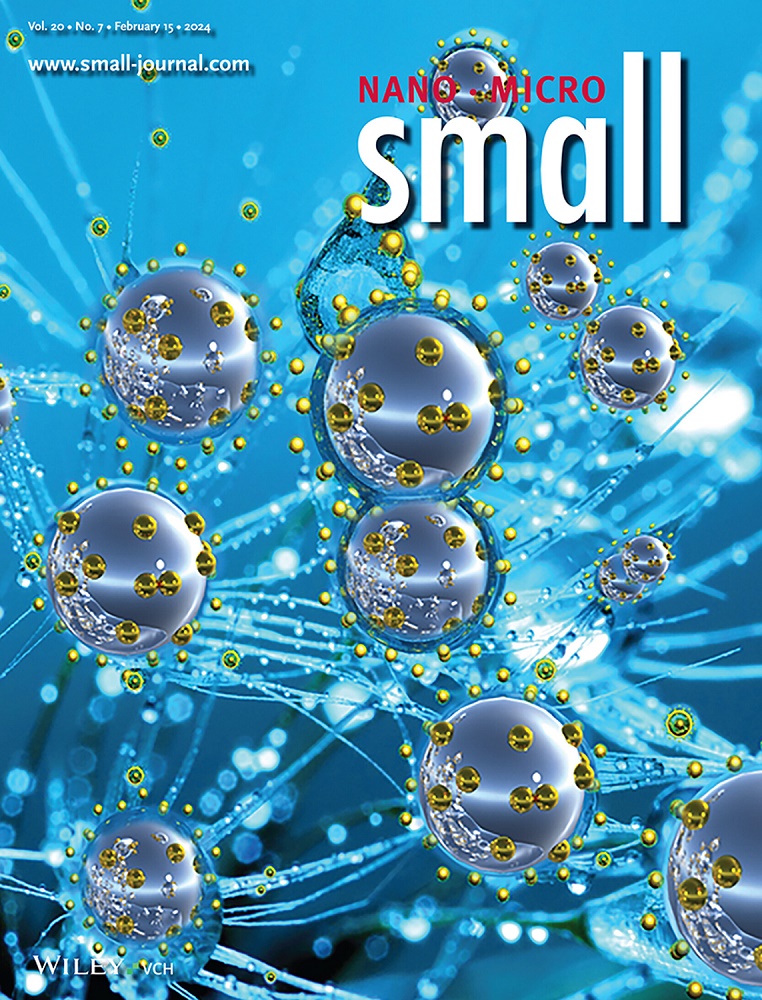Bimetallic Cu/Zn Single-Atom Nanozyme with Superoxide Dismutase-Like Activity.
IF 13
2区 材料科学
Q1 CHEMISTRY, MULTIDISCIPLINARY
引用次数: 0
Abstract
The superoxide ion (O2•-), a radical species, is significant in chemical and biological systems. Nanozymes, enzyme-mimicking nanomaterials, have been developed to replicate superoxide dismutase (SOD), which counters O2•-. Traditionally, nano ceria (CeO2) is used for SOD mimicry due to its Ce3+/Ce4+ cycling ability, but issues like toxicity, biodistribution, aggregation, and specificity hinder practical use. Single-atom nanozymes (SANs) offer a solution, with metal centers mimicking natural metal-based enzymes. A Cu/Zn bimetallic SAN is synthesized, structurally resembling natural SOD and exhibiting comparable activity. Its performance is assessed by capturing superoxide radicals and inhibiting Nitro-blue tetrazolium (NBT) photoreduction to blue Formazan. The Cu/Zn-SAN shows a half-maxima inhibitory concentration (IC50) of 0.115 µg mL-1 and a catalytic activity of 7820 U mg-1, compared to 4264 U mg-1 for the natural SOD enzyme. Unlike many dual-metal nanozymes with multiple ROS activities, Cu/Zn-SAN selectively mimics SOD activity with no detectable oxidase or peroxidase-like behavior. Additionally, its performance in cigarette smoke extract demonstrates its practical relevance and biological safety. These findings highlight its potential for reducing oxidative stress in cardiovascular, inflammatory, and neurodegenerative diseases, as well as applications in cosmetic anti-aging products and skin protection, offering a promising alternative to traditional nanozymes.具有超氧化物歧化酶样活性的双金属铜/锌单原子纳米酶。
超氧离子(O2•-)是一种自由基,在化学和生物系统中具有重要意义。纳米酶是一种模拟酶的纳米材料,用于复制对抗O2•-的超氧化物歧化酶(SOD)。传统上,纳米氧化铈(CeO2)由于其Ce3+/Ce4+循环能力而被用于SOD模拟,但诸如毒性、生物分布、聚集和特异性等问题阻碍了其实际应用。单原子纳米酶(SANs)提供了一种解决方案,其金属中心模仿天然金属基酶。合成了一种Cu/Zn双金属SAN,其结构与天然SOD相似,且具有相当的活性。通过捕获超氧自由基和抑制硝基蓝四氮唑(NBT)光还原成蓝色甲醛来评价其性能。Cu/Zn-SAN的半最大抑制浓度(IC50)为0.115µg mL-1,催化活性为7820 U mg-1,而天然SOD酶的催化活性为4264 U mg-1。与许多具有多种ROS活性的双金属纳米酶不同,Cu/Zn-SAN选择性地模拟SOD活性,而没有检测到氧化酶或过氧化物酶样行为。此外,它在香烟烟雾提取物中的表现也证明了它的实用性和生物安全性。这些发现强调了它在减少心血管、炎症和神经退行性疾病的氧化应激方面的潜力,以及在化妆品抗衰老产品和皮肤保护方面的应用,为传统纳米酶提供了一个有希望的替代品。
本文章由计算机程序翻译,如有差异,请以英文原文为准。
求助全文
约1分钟内获得全文
求助全文
来源期刊

Small
工程技术-材料科学:综合
CiteScore
17.70
自引率
3.80%
发文量
1830
审稿时长
2.1 months
期刊介绍:
Small serves as an exceptional platform for both experimental and theoretical studies in fundamental and applied interdisciplinary research at the nano- and microscale. The journal offers a compelling mix of peer-reviewed Research Articles, Reviews, Perspectives, and Comments.
With a remarkable 2022 Journal Impact Factor of 13.3 (Journal Citation Reports from Clarivate Analytics, 2023), Small remains among the top multidisciplinary journals, covering a wide range of topics at the interface of materials science, chemistry, physics, engineering, medicine, and biology.
Small's readership includes biochemists, biologists, biomedical scientists, chemists, engineers, information technologists, materials scientists, physicists, and theoreticians alike.
 求助内容:
求助内容: 应助结果提醒方式:
应助结果提醒方式:


